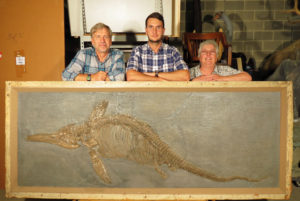160 Years After Its Arrival, New Ichthyosaurus Identified at the Academy
PHILADELPHIA,
October 6, 2016

The Ichthyosaurus somersetensis specimen at the Academy with (from L–R) Ted Daeschler, Dean Lomax and Judy Massare.
Click here for full image.
More than 160 years after its discovery in an English quarry, an ancient aquatic reptile specimen at the Academy of Natural Sciences of Drexel University has finally been given its own name.
In the effort to identify more ichthyosaurs, the University of Manchester’s Dean Lomax and Brockport College’s Judy Massare, PhD, examined a specimen stored at the Academy and determined that it was a new species. In honor of where it was found, Somerset County, they named the Jurassic-era animal Ichthyosaurus somersetensis.
Ted Daeschler, PhD, vice president for collections and the library of the Academy of Natural Sciences and keeper of the specimen, was “thrilled” with being able to help the new discovery.
“Being part of identifying new species is always a thrilling endeavor,” he said. “With each new species, you’re adding knowledge of a unique biological thread that helps to weave together the tapestry of life on Earth.”
Lomax called the Academy’s 200-million-year-old specimen, which is a complete skeleton encased in a slab of rock, “the best example of Ichthyosaurus collected to date.”
But how did it get to the Academy?
It turns out, the fossil was discovered in a Glastonberry, Somerset, quarry at some point in the 1840s. It was passed on to Edward Wilson, of Tenby, South Wales, who decided to forward it to his brother, Thomas Wilson, who lived in Delaware and happened to be an Academy trustee.
Once it arrived in 1847, Thomas donated the ichthyosaurus specimen to the Academy, where it has remained since and periodically been a part of public displays.
Lomax and Massare’s recent examination of the species uncovered unique skeletal anatomy of this specimen that finally made the reptile its own species.
Although many years have elapsed since its arrival at the Academy and its official identification, Daeschler said such happenings aren’t uncommon.
“Specimen collections of fossils or living plants and animals are frequently re-examined in light of additional knowledge or investigative techniques,” Daeschler said. “Thus, new species are frequently recognized from collections, even those that came in long ago.”
Something similar to the identification of Ichthyosaurus somersetensis happened late last year, but in reverse. A specimen of a jawbone, that had resided at the Academy as Bathygnathus borealis since 1845, was examined by Canadian scientists and determined to actually belong to the genus Dimetrodon, a relatively well-known sail-backed reptile from 40 million years before the earliest dinosaurs.
Discoveries like these help paint a fuller picture of the history of life for researchers and are only possible with physical collections like the Academy’s.
“Research collections are indispensable resources for a wide array of scientific endeavors,” Daeschler explained. “Documenting biodiversity, past and present, is just the tip of the iceberg.”
Media Contact